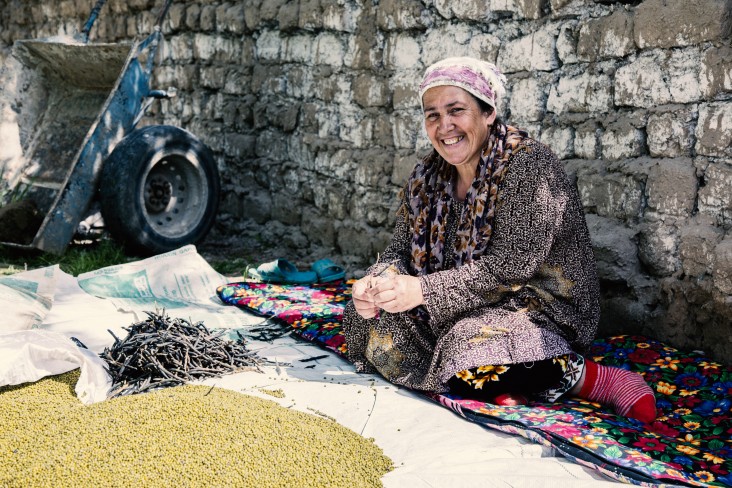
June 2017—Rajabmo Nazarova is one of many female farmers in the Khatlon province of southern Tajikistan who face difficulties feeding her large family. Although agriculture is the main industry in the region, undernutrition remains very high in Khatlon. In particular, children under 5 years old and women of reproductive age are most vulnerable to undernourishment. One in three children are stunted.
Sixty-four percent of people live below the poverty line and suffer from chronic food insecurity. This food insecurity is partly due to the fact that farmers lack technologies and skills of modern crop production to produce enough nutritious food.
When she heard about mung bean demonstration plots—part of the Feed the Future Tajikistan Agriculture and Water Activity—Nazarova was eager to participate. Although she had planted mung beans in the past, her harvest was very poor.
Feed the Future, which is the U.S. Government’s global hunger and food security initiative, is led by USAID.
Nazarova and 11 other female farmers participated in regularly conducted training sessions during July-October 2016 and joined 500 farmers in open field day events, conducted on their plots, learning how to increase mung bean harvests through the use of improved seed, proper seed and row spacing, and the drill-sowing technique. In addition to the training sessions, participants received new recipes and information on the nutritional value and economic advantages of producing mung beans.
As a result of applying these new techniques, Nazarova’s mung bean harvest increased sixfold, using half as many seeds.
“Last year, when I planted mung beans, I planted 50 kilograms of seeds and received only 450 kilograms of harvest. This year, I was trained by the Feed the Future Tajikistan Agriculture and Water Activity specialists and received 2,800 kilograms of harvest from the same area of land using 22 kilograms of seeds,” says Nazarova.
“My wife prepared cutlets from mung beans and they were really tasty, just like meat,” said Nazarov’s husband, Murodali. “The mung bean is very good for health as well. It is rich in vitamins and helps to prevent many diseases.”
Nazarova sold 2,000 kilograms of her harvest in the local market, making about $2,000, while keeping the surplus for family consumption and seeds for the next planting season. Now she can feed her family, and with the profit, she expanded into livestock, buying three cows and a bull. She plans to open a milk production workshop that will also provide her female neighbors with work opportunities.
The Tajikistan Agriculture and Water Activity runs from October 2015 to September 2018. It assists entrepreneurs, farmers and backyard gardeners to increase, diversify and add value to the production, post-harvest handling, and processing of nutritious agricultural products. The goal is to boost yields and harvest quality for increased household consumption and income generation through the sale of surplus in a local market.
As a result of the success of the 12 demonstration plots, many of the 500 farmers trained through the open field days expressed interest in planting mung beans the following year. In response, the project plans to introduce a voucher program for mung bean production during July-October 2017. The program goal is to cover half the cost of seed and other inputs to more than 300 farmers to plant improved mung beans on 300 hectares of land.
Based on last year’s successes, the voucher program is expected to result in a total harvest of 450 to 500 metric tons, creating an economic profit of more than $500,000. In a province as poor and malnourished as Khatlon, it is hard to overstate the potential for this crop to improve nutrition and increase incomes.
LINKS
Follow @USAIDCtrAsia, on Facebook, on Flickr, on YouTube







Comment
Make a general inquiry or suggest an improvement.